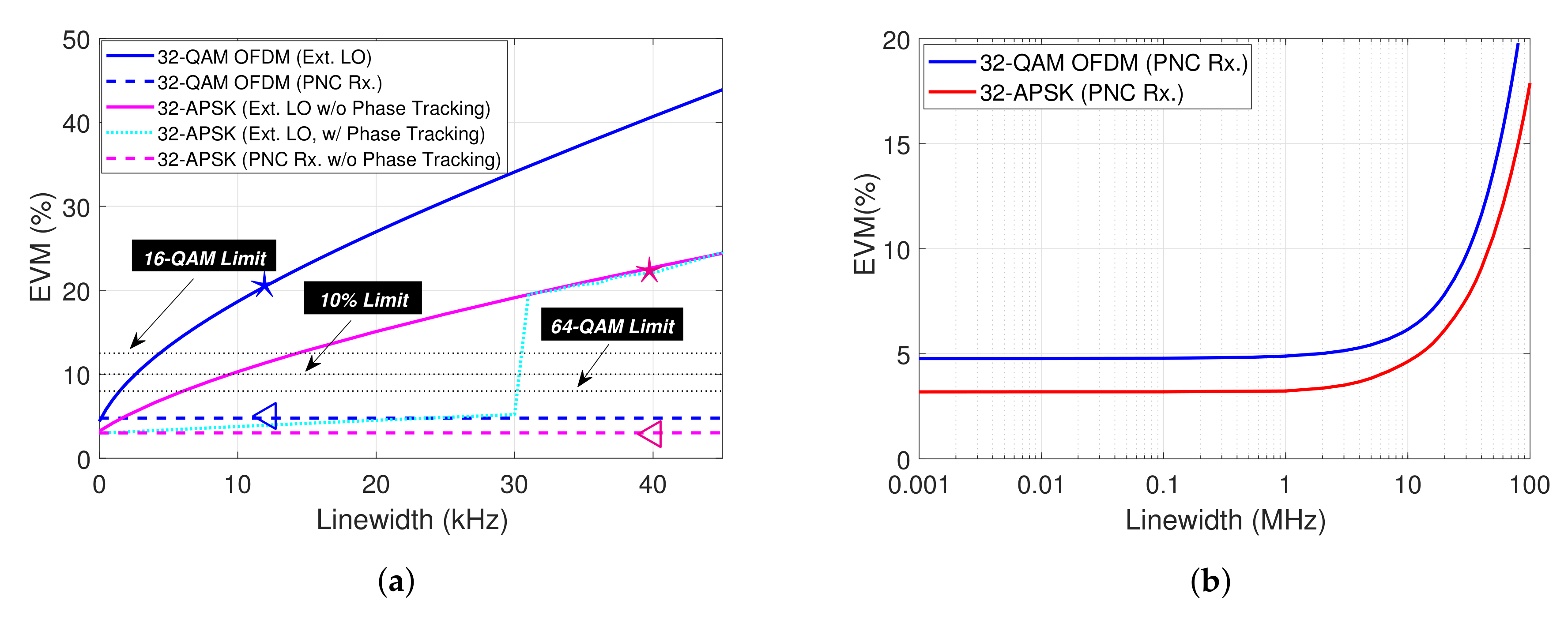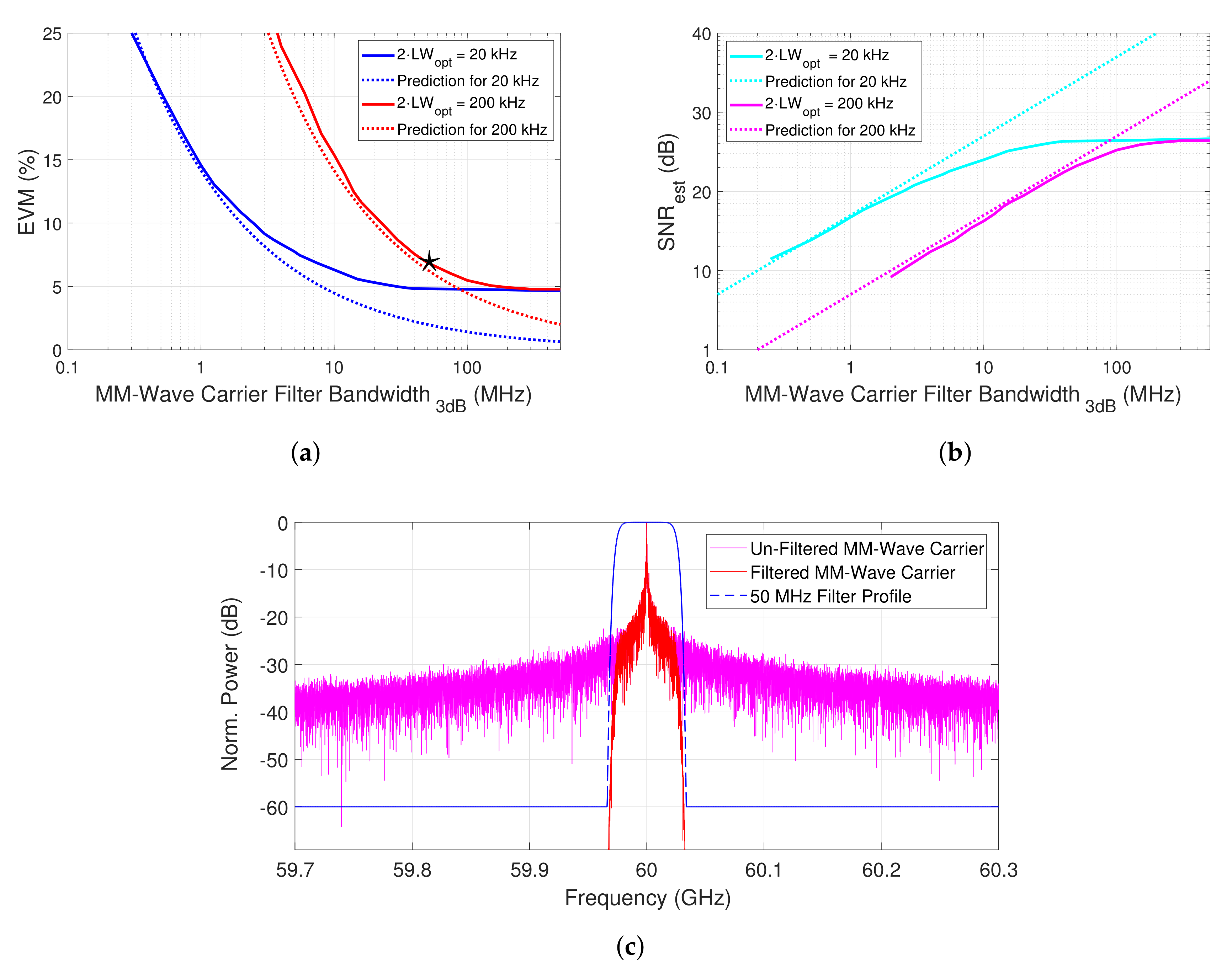Analysis of Phase Noise in a Hybrid Photonic/Millimetre-Wave System for Single and Multi-Carrier Radio Applications
Abstract
:1. Introduction
2. Millimetre-Wave Network Applications
2.1. Terrestrial
2.2. Satellite
3. Waveforms for Millimetre-Wave Mobile Communications
4. Hybrid Photonic/Millimetre-Wave System and Simulation Details
4.1. System Simulation
- LO-based Receiver: A standard receiver structure consisting of a mm-wave mixer and local oscillator (LO) is depicted in the lower half of the receiver side in Figure 1. The incoming signal is passed through an electrical band-pass filter (EBPF), which serves to isolate the upper data sideband portion of the mm-wave spectrum, centred at 62 GHz. The filtered signal is mixed with a 60 GHz carrier generated by the receiver LO, which is phase locked to the transmitter side. The down-converted IF signal at 2 GHz is then passed to the IF OFDM/APSK demodulator.
- PNC Receiver: The analog phase noise cancelling mm-wave receiver architecture is outlined by a dotted red line in Figure 1. This architecture allows phase noise and frequency offset cancellation at the IF down-conversion stage without the requirement for a standalone receiver LO, and this is described in detail in [11]. After photo detection, the electrical spectrum shown in Figure 2c is split into two paths. The PNC receiver contains an EBPF in each path; a signal filter and a carrier filter, which are used to isolate the upper data sideband (at 62 GHz) and mm-wave carrier term (at 60 GHz), respectively (these terms are represented by the purple illustrative spectra in Figure 1). The filtered signal and carrier terms are then used as the ‘RF’ and ‘LO’ inputs to a mm-wave mixer, respectively. These filtered components exhibit matching phase noise as a result of being generated through the same photo-mixing process. This allows the filtered carrier term to be used as a phase noise correlated ‘LO’, which, when mixed with the signal term, produces an IF data signal (at 2 GHz) free from phase noise.
4.2. Waveform Generation and Reception
5. Results and Discussion
5.1. OFDM Versus APSK
5.2. Impact of PNC Receiver Design
6. Conclusions
Author Contributions
Funding
Conflicts of Interest
Appendix A
References
- 3GPP. 3GPP TR 21.915 V15.0.0; Technical Report; ETSI: Valbonne, France, 2019; p. 25. [Google Scholar]
- Wei, L.; Hu, R.Q.; Qian, Y.; Wu, G. Key elements to enable millimeter wave communications for 5G wireless systems. IEEE Wirel. Commun. 2014, 21, 136–143. [Google Scholar]
- De Sanctis, M.; Cianca, E.; Rossi, T.; Sacchi, C.; Mucchi, L.; Prasad, R. Waveform design solutions for EHF broadband satellite communications. IEEE Commun. Mag. 2015, 53, 18–23. [Google Scholar] [CrossRef]
- Alavi, S.; Soltanian, M.; Amiri, I.; Khalily, M.; Supa’at, A.; Ahmad, H. Towards 5G: A Photonic Based Millimeter Wave Signal Generation for Applying in 5G Access Fronthaul. Sci. Rep. 2016, 6, 2045–2322. [Google Scholar] [CrossRef] [PubMed] [Green Version]
- Browning, C.; Elwan, H.H.; Martin, E.P.; O’Duill, S.; Poette, J.; Sheridan, P.; Farhang, A.; Cabon, B.; Barry, L.P. Gain-Switched Optical Frequency Combs for Future Mobile Radio-Over-Fiber Millimeter-Wave Systems. J. Light. Technol. 2018, 36, 4602–4610. [Google Scholar] [CrossRef]
- Stohr, A.; Heinzelmann, R.; Malcoci, A.; Jager, D. Optical heterodyne millimeter-wave generation using 1.55-/spl mu/m traveling-wave photodetectors. IEEE Trans. Microw. Theory Tech. 2001, 49, 1926–1933. [Google Scholar] [CrossRef]
- Shams, H.; Fice, M.J.; Balakier, K.; Renaud, C.C.; van Dijk, F.; Seeds, A.J. Photonic generation for multichannel THz wireless communication. Opt. Express 2014, 22, 23465–23472. [Google Scholar] [CrossRef] [PubMed]
- Puerta, R.; Yu, J.; Li, X.; Xu, Y.; Vegas Olmos, J.J.; Tafur Monroy, I. Single-Carrier Dual-Polarization 328-Gb/s Wireless Transmission in a D-Band Millimeter Wave 2 × 2 MU-MIMO Radio-Over-Fiber System. J. Light. Technol. 2018, 36, 587–593. [Google Scholar] [CrossRef]
- Delmade, A.; Verolet, T.; Browning, C.; Lin, Y.; Aubin, G.; Lelarge, F.; Ramdane, A.; Barry, L.P. Quantum Dash Passively Mode Locked Laser for Optical Heterodyne Millimeter-Wave Analog Radio-over-Fiber Fronthaul Systems. In Proceedings of the Optical Fiber Communication Conference (OFC) 2020, San Diego, CA, USA, 8–12 March 2020; Optical Society of America: Washington, DC, USA, 2020; p. 2. [Google Scholar] [CrossRef]
- Browning, C.; Martin, E.P.; Farhang, A.; Barry, L.P. 60 GHz 5G Radio-Over-Fiber Using UF-OFDM With Optical Heterodyning. IEEE Photonics Technol. Lett. 2017, 29, 2059–2062. [Google Scholar] [CrossRef] [Green Version]
- Browning, C.; Delmade, A.; Lin, Y.; Poette, J.; Elwan, H.H.; Barry, L. Phase Noise Robust Optical Heterodyne System for Reduced Complexity Millimeter-Wave Analog Radio-over-Fibre. In Proceedings of the European Conference on Optical Communication, Dublin, Ireland, 22–26 September 2019. [Google Scholar]
- Gomes, N.J.; Assimakopoulos, P.; Al-Hares, M.K.; Habib, U.; Noor, S. The new flexible mobile fronthaul: Digital or analog, or both? In Proceedings of the 18th International Conference on Transparent Optical Networks (ICTON), Trento, Italy, 10–14 July 2016; pp. 1–4. [Google Scholar]
- Breyne, L.; Torfs, G.; Yin, X.; Demeester, P.; Bauwelinck, J. Comparison Between Analog Radio-Over-Fiber and Sigma Delta Modulated Radio-Over-Fiber. IEEE Photonics Technol. Lett. 2017, 29, 1808–1811. [Google Scholar] [CrossRef] [Green Version]
- Li, W.; Chen, A.; Li, T.; Penty, R.V.; White, I.H.; Wang, X. Novel Digital Radio Over Fiber (DRoF) System With Data Compression for Neutral-Host Fronthaul Applications. IEEE Access 2020, 8, 40680–40691. [Google Scholar] [CrossRef]
- Delmade, A.; Browning, C.; Farhang, A.; Marchetti, N.; Doyle, L.; Koilpillai, R.; Barry, L.; Venkitesh, D. Performance Analysis of Analog IF Over Fiber Fronthaul Link With 4G and 5G Coexistence. J. Opt. Commun. Netw. 2018, 10, 174–182. [Google Scholar] [CrossRef]
- Ruggeri, E.; Tsakyridis, A.; Vagionas, C.; Leiba, Y.; Kalfas, G.; Pleros, N.; Miliou, A. Multi-user V-band uplink using a massive MIMO antenna and a fiber-wireless IFoF fronthaul for 5G mmWave small-cells. J. Light. Technol. 2020. [Google Scholar] [CrossRef]
- Morant, M.; Trinidad, A.; Tangdiongga, E.; Koonen, T.; Llorente, R. Experimental Demonstration of mm-Wave 5G NR Photonic Beamforming Based on ORRs and Multicore Fiber. IEEE Trans. Microw. Theory Tech. 2019, 67, 2928–2935. [Google Scholar] [CrossRef]
- Kanno, A.; Dat, P.T.; Yamamoto, N.; Kawanishi, T. Millimeter-Wave Radio-Over-Fiber Network for Linear Cell Systems. J. Light. Technol. 2018, 36, 533–540. [Google Scholar] [CrossRef]
- Kaszubowska-Anandarajah, A.; Delmade, A.; Martin, E.; Anandarajah, P.; Barry, L.; Browning, C. Bidirectional fiber transmission of mmW signals using remote downconversion and wavelength reuse. In Proceedings of the Conference on Lasers and Electro-Optics, San Jose, CA, USA, 5–10 May 2019; Optical Society of America: Washington, DC, USA, 2019; p. 4. [Google Scholar]
- Carpintero, G.; Balakier, K.; Yang, Z.; Guzman, R.C.; Corradi, A.; Jimenez, A.; Kervella, G.; Fice, M.J.; Lamponi, M.; Chitoui, M.; et al. Microwave Photonic Integrated Circuits for Millimeter-Wave Wireless Communications. J. Light. Technol. 2014, 32, 3495–3501. [Google Scholar] [CrossRef]
- Li, X.; Yu, J. Generation and Heterodyne Detection of >100-Gb/s Q -Band PDM-64QAM mm-Wave Signal. IEEE Photonics Technol. Lett. 2017, 29, 27–30. [Google Scholar] [CrossRef]
- Beidas, B.F. Radio-Frequency Impairments Compensation in Ultra High-Throughput Satellite Systems. IEEE Trans. Commun. 2019, 67, 6025–6038. [Google Scholar] [CrossRef]
- Giambene, G.; Kota, S.; Pillai, P. Satellite-5G Integration: A Network Perspective. IEEE Netw. 2018, 32, 25–31. [Google Scholar] [CrossRef]
- Jia, M.; Gu, X.; Guo, Q.; Xiang, W.; Zhang, N. Broadband Hybrid Satellite-Terrestrial Communication Systems Based on Cognitive Radio toward 5G. IEEE Wirel. Commun. 2016, 23, 96–106. [Google Scholar] [CrossRef]
- Kodheli, O.; Lagunas, E.; Maturo, N.; Sharma, S.K.; Shankar, B.; Montoya, J.F.M.; Duncan, J.C.M.; Spano, D.; Chatzinotas, S.; Kisseleff, S.; et al. Satellite Communications in the New Space Era: A Survey and Future Challenges. arXiv 2020, arXiv:eess.SP/2002.08811. [Google Scholar]
- Bacco, M.; Davoli, F.; Giambene, G.; Gotta, A.; Luglio, M.; Marchese, M.; Patrone, F.; Roseti, C. Networking Challenges for Non-Terrestrial Networks Exploitation in 5G. In Proceedings of the IEEE 2nd 5G World Forum (5GWF), Dresden, Germany, 30 September–2 October 2019; pp. 623–628. [Google Scholar]
- Arapoglou, P.D.M.; Cioni, S.; Re, E.; Ginesi, A. Direct Access to 5G New Radio User Equipment from NGSO Satellites in Millimeter Waves. arXiv 2020, arXiv:abs/2003.11078. [Google Scholar]
- Pan, S.; Zhu, D.; Liu, S.; Xu, K.; Dai, Y.; Wang, T.; Liu, J.; Zhu, N.; Xue, Y.; Liu, N. Satellite Payloads Pay Off. IEEE Microw. Mag. 2015, 16, 61–73. [Google Scholar] [CrossRef]
- Delmade, A.; Browning, C.; Farhang, A.; Koilpillai, R.D.; Venkitesh, D.; Barry, L.P. OFDM Baud Rate Limitations in an Optical Heterodyne Analog Fronthaul Link using Unlocked Fibre Lasers. In Proceedings of the International Topical Meeting on Microwave Photonics (MWP), Ottawa, ON, Canada, 7–10 October 2019; pp. 1–4. [Google Scholar]
- Arapoglou, P.D.; Ginesi, A.; Cioni, S.; Erl, S.; Clazzer, F.; Andrenacci, S.; Vanelli-Coralli, A. DVB-S2X-enabled precoding for high throughput satellite systems. Int. J. Satell. Commun. Netw. 2016, 34, 439–455. [Google Scholar] [CrossRef] [Green Version]
- Beidas, B.F.; Iyer Seshadri, R. OFDM-Like Signaling for Broadband Satellite Applications: Analysis and Advanced Compensation. IEEE Trans. Commun. 2017, 65, 4433–4445. [Google Scholar] [CrossRef]
- Guidotti, A.; Vanelli-Coralli, A.; Conti, M.; Andrenacci, S.; Chatzinotas, S.; Maturo, N.; Evans, B.; Awoseyila, A.; Ugolini, A.; Foggi, T.; et al. Architectures and Key Technical Challenges for 5G Systems Incorporating Satellites. IEEE Trans. Veh. Technol. 2019, 68, 2624–2639. [Google Scholar] [CrossRef] [Green Version]
- Hinkley, E.D.; Freed, C. Direct Observation of the Lorentzian Line Shape as Limited by Quantum Phase Noise in a Laser above Threshold. Phys. Rev. Lett. 1969, 23, 277–280. [Google Scholar] [CrossRef]
- Colavolpe, G.; Barbieri, A.; Caire, G. Algorithms for iterative decoding in the presence of strong phase noise. IEEE J. Sel. Areas Commun. 2005, 23, 1748–1757. [Google Scholar] [CrossRef]
- Grootjans, R.; Roeloffzen, C.; Taddei, C.; Hoekman, M.; Wevers, L.; Visscher, I.; Kapteijn, P.; Geskus, D.; Alippi, A.; Dekker, R.; et al. Broadband Continuously Tuneable Delay Microwave Photonic Beamformer for Phased Array Antennas. In Proceedings of the 49th European Microwave Conference (EuMC), Paris, France, 1–3 October 2019; pp. 812–815. [Google Scholar]
- Cao, Z.; Ma, Q.; Smolders, A.B.; Jiao, Y.; Wale, M.J.; Oh, C.W.; Wu, H.; Koonen, A.M.J. Advanced Integration Techniques on Broadband Millimeter-Wave Beam Steering for 5G Wireless Networks and Beyond. IEEE J. Quantum Electron. 2016, 52, 1–20. [Google Scholar] [CrossRef]






| S.No. | Property | Value |
|---|---|---|
| 1. | mmWave Carrier Frequency | 60 GHz |
| 2. | Intermediate Frequency | 2 GHz |
| 3. | Optical Linewidth | Variable |
| 4. | RIN | −140 dB/Hz |
| 5. | Carrier Frequency Offset | 0 Hz |
| 6. | System Sample Rate | 200 GSa/s |
| S.No. | Property | APSK | OFDM |
|---|---|---|---|
| 1. | Total Data Rate | 1 Gb/s | 0.98 Gb/s |
| 2. | Bandwidth | 200 MHz (3-dB) | 195.2 MHz |
| 3. | Modulation Order | 32 | 32 |
| 4. | Phase Tracking/EQ | LMS | Single-Tap FDE |
| 5. | No. Subcarriers | - | 800 |
| 6. | FFT Size | - | 1024 |
| 7. | Subcarrier Spacing | - | 244 kHz |
| 8. | CP | - | 6.25% |
© 2020 by the authors. Licensee MDPI, Basel, Switzerland. This article is an open access article distributed under the terms and conditions of the Creative Commons Attribution (CC BY) license (http://creativecommons.org/licenses/by/4.0/).
Share and Cite
Dass, D.; O'Duill, S.; Delmade, A.; Browning, C. Analysis of Phase Noise in a Hybrid Photonic/Millimetre-Wave System for Single and Multi-Carrier Radio Applications. Appl. Sci. 2020, 10, 5800. https://doi.org/10.3390/app10175800
Dass D, O'Duill S, Delmade A, Browning C. Analysis of Phase Noise in a Hybrid Photonic/Millimetre-Wave System for Single and Multi-Carrier Radio Applications. Applied Sciences. 2020; 10(17):5800. https://doi.org/10.3390/app10175800
Chicago/Turabian StyleDass, Devika, Sean O'Duill, Amol Delmade, and Colm Browning. 2020. "Analysis of Phase Noise in a Hybrid Photonic/Millimetre-Wave System for Single and Multi-Carrier Radio Applications" Applied Sciences 10, no. 17: 5800. https://doi.org/10.3390/app10175800





